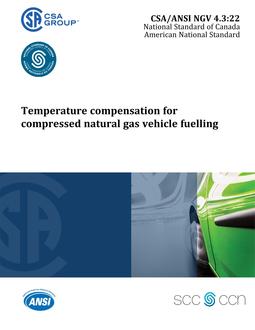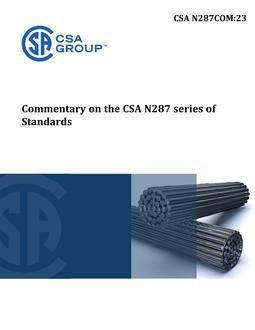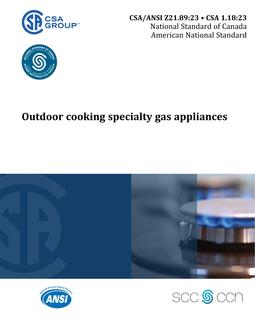
CSA /ANSI NGV 4.3:22
- Comments Off on CSA /ANSI NGV 4.3:22
- CSA
Preface
This is the second edition of CSA/ANSI NGV 4.3, Temperature compensation for compressed natural gas vehicle fuelling. It supersedes the previous edition, published in 2018 under the title Temperature compensation guideline for compressed natural gas vehicle fueling. This Standard is based on proven engineering principles, research, and the combined expertise of gas utilities, manufacturers, users, and others having specialized experience. The major changes to this edition include the following: a) this Standard may now be used for conformity assessment; b) newly manufactured dispensing systems are now included in the scope; and c) physical and simulation testing requirements have been added for newly manufactured dispensing systems through gas temperature versus settled gas pressure verification test methods. CSA Group acknowledges that the development of this Standard was made possible, in part, by the financial support of Natural Resources Canada. This Standard is considered suitable for use for conformity assessment within the stated scope of the Standard. This Standard was prepared by the Subcommittee on Temperature Compensation Devices and Priority and Sequencing Equipment for Natural Gas Vehicles, under the jurisdiction of the Technical Committee on Natural Gas Transportation and the Strategic Steering Committee on Transportation, and has been formally approved by the Technical Committee and the Interprovincial/Territorial Gas Advisory Council. This Standard has been developed in compliance with Standards Council of Canada requirements for National Standards of Canada. It has been published as a National Standard of Canada by CSA Group. This Standard has been approved by the American National Standards Institute (ANSI) as an American National Standard.
Scope
1.1 Inclusions
This Standard details the safety and performance requirements for temperature compensation control used to prevent compressed natural gas (CNG) dispensing systems from exceeding a safe fill level for vehicle fuel storage container(s). This Standard contains safety performance requirements for compressed natural gas fuelling dispenser temperature compensation systems. It applies to newly manufactured dispensing systems and the field evaluation of existing dispensing systems designed primarily to allow for full fill and to avoid over-pressurization of vehicle fuel storage containers under the operating temperature conditions as specified in this Standard. This Standard applies to CNG fuelling of vehicle containers with service pressures of a) P30 [20 700 kPa (3000 psi)]; b) P30HD [20 700 kPa (3000 psi)]; c) P36 [24 800 kPa (3600 psi)]; and d) P36HD [24 800 kPa (3600 psi)]. P30HD and P36HD are designations used in accordance with CSA/ANSI NGV 1, and throughout the document, the use of P30 and P36 are also applicable to P30HD and P36HD, respectively (see Annex A of this Standard regarding applicable vehicle service pressures). This Standard is applicable to the dispensing of only natural gas that meets quality and specifications contained in ASTM D8080.
1.2 Pressure references
All references to pressure throughout this document are to be considered gauge pressures unless otherwise specified.
1.3 Quality and innovation
Nothing in this Standard is to be considered in any way as indicating a measure of quality beyond compliance with the provisions it contains. It is designed to allow compliance of products that may exceed what is specified in the provisions herein. The requirements of this Standard are not intended to constrain innovation. In its preparation, full recognition has been given to possibilities of improvement through ingenuity of design. When considering fuel compositions, controls, materials, designs, or constructions not specifically dealt with in this Standard, these alternatives are to be evaluated as to their ability to yield levels of safety and performance equivalent to or better than those prescribed by this Standard. Note: This Standard is subject to revision as further experience and investigation show it is necessary and desirable.
1.4 Precedence
Users of this Standard are advised that the devices, products, and activities within its scope might be subject to regulation at the federal, state, provincial, or local levels. Users are strongly urged to investigate this possibility through appropriate channels. In the case of a conflict between this Standard and federal, provincial, state, or local regulations, the governmental requirements take precedence.
1.5 Terminology
In this Standard, “shall” is used to express a requirement, i.e., a provision that the user is obliged to satisfy in order to comply with the standard; “should” is used to express a recommendation or that which is advised but not required; and “may” is used to express an option or that which is permissible within the limits of the Standard. Notes accompanying clauses do not include requirements or alternative requirements; the purpose of a note accompanying a clause is to separate from the text explanatory or informative material. Notes to tables and figures are considered part of the table or figure and may be written as requirements. Annexes are designated normative (mandatory) or informative (non-mandatory) to define their application.
1.6 Units of measurement
All dimensions used in this Standard are in SI units, unless otherwise specified. If a value for a measurement, as given in this Standard, is followed by an equivalent value in other units, the first stated value is to be regarded as the specification. If a value for a measurement and a corresponding value in other units are both specified as a quoted marking requirement, either the first stated unit, or both, are to be provided.
Product Details
- Edition:
- 2nd
- Published:
- 09/21/2022
- ISBN(s):
- 9781488344848
- Number of Pages:
- 48
- File Size:
- 1 file , 990 KB
- Product Code(s):
- 2430257, 2430257
- Note:
- This product is unavailable in Russia, Ukraine, Belarus



